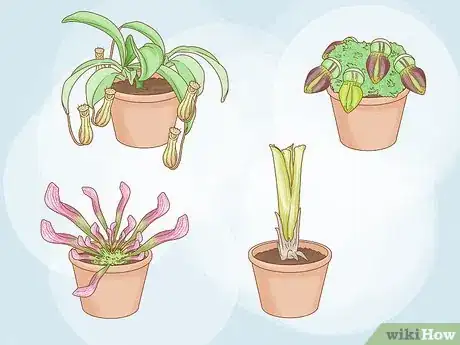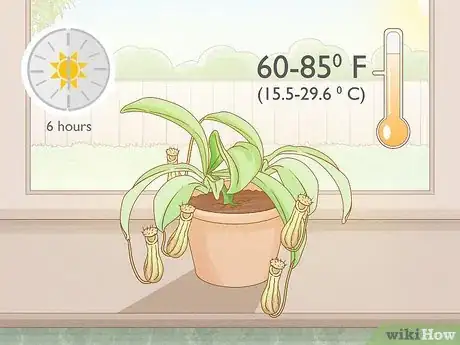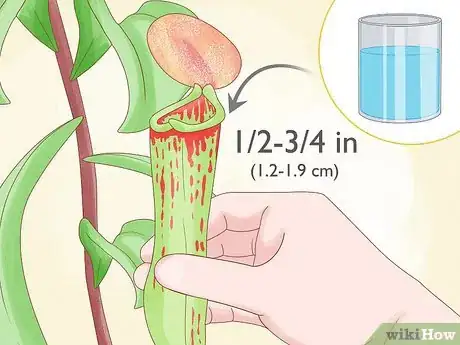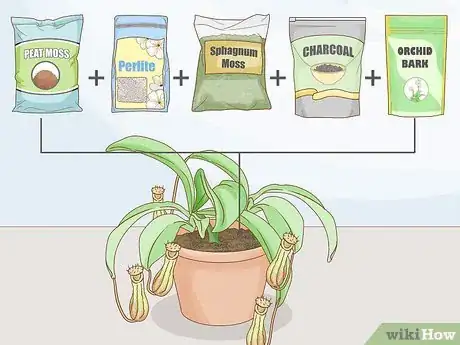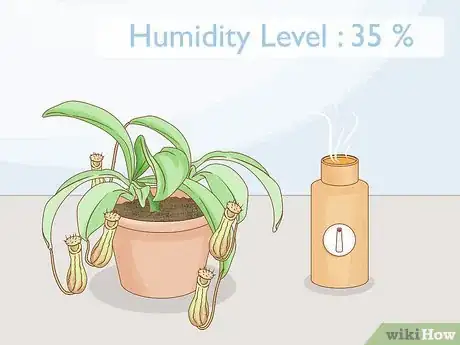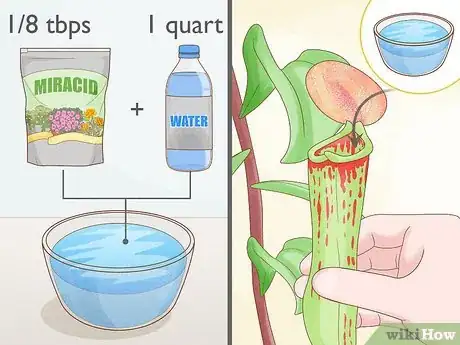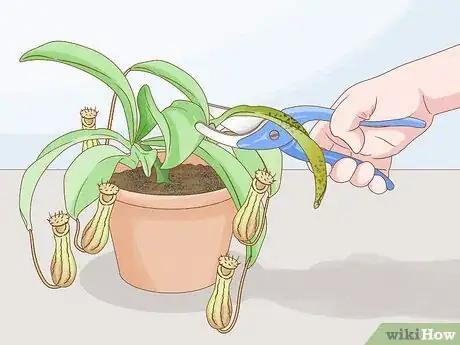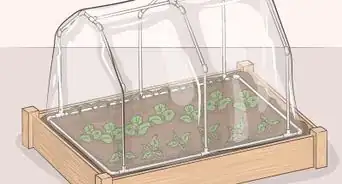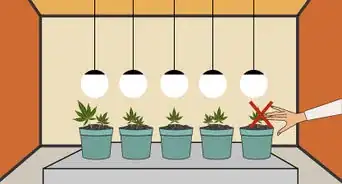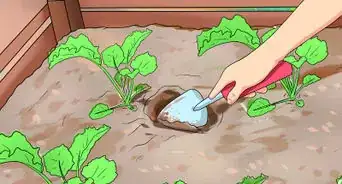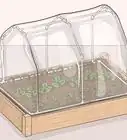wikiHow is a “wiki,” similar to Wikipedia, which means that many of our articles are co-written by multiple authors. To create this article, 34 people, some anonymous, worked to edit and improve it over time.
There are 10 references cited in this article, which can be found at the bottom of the page.
This article has been viewed 559,531 times.
Learn more...
Pitcher plants are carnivorous plants able to use their tube-shaped leaves to trap and digest insects.[1] The insects are drawn in by a sweet nectar and visual lures. The inside of the tube is often too slippery for the insect to climb out. When the insects fall into the pool of water on the inside, the insects are digested by enzymes or bacteria. The reason these plants formed this method of seeking nutrition is because their native soils lack minerals or are very acidic, and this method enables the plants to compensate by getting nutrients from insects. It's possible to grow these fascinating plants at home, just follow the steps.
Steps
-
1Research the requirements of each species. Carnivorous pitcher plants can be found all over the world, so the requirements to grow them vary according to the region from which they are sourced. Read a few quality books on the subject to give you a solid understanding of the plants and their needs. A brief overview of the different types of pitcher plants follows:
- Nepenthes, tropical pitcher plants, monkey cups - There are about 120 species in the Nepenthes genus and they grow in the Old World tropics (mostly in the Malay archipelago). Most of these species will require high humidity, lots of water, and moderate to high light levels (similar to orchids).[2] These are not ideal "beginner" plants.[3]
-
Sarraceniaceae - This family of pitcher plants grow in the New World and can be broken down into three genera (groups of species):
- Sarracenia - All of these species grow in North America. They require require a distinct summer and winter, strong, direct sunlight, and lots of water.
- Darlingtonia - These species are limited to Oregon and northern California and are difficult to grow. The roots need to be kept cooler than the rest of the plant because they grow in environments with cold running water.
- Heliamphora - All of these species are native to South America. They are also difficult to cultivate.
- Cephalotus - There's only one species in this genus (Cephalotus follicularis) and it can be grown like any subtropical plant.
- Bromeliaceae - This is the same family that contains pineapples. One or two species in this family are believed to be carnivorous. They don't form the characteristic pitcher shape.
-
2Obtain the plants. Once you've decided which species you're best prepared to grow, start looking for a source. Your best bet is to find a reputable greenhouse and purchase a healthy pitcher plant from there. Ask the assistants for additional tips on growing that particular species.
- It's also possible to order pitcher plants online, but they can get damaged and die during shipping.
- Although it's possible to grow pitcher plants from seeds or cuttings, this is not advised for beginners.
Advertisement -
3Place the plant in a sunny location receiving at least six hours of direct sunlight. Ideal temperatures range between 60ºF to 85ºF (15.5ºC to 29.6ºC). The beautiful coloring of the pitcher plant will be much more intense if the plant receives at least a couple hours of bright, full sunlight each day, but will also grow reasonably well in partial shade. Most people grow pitcher plants in a greenhouse environment or in a terrarium.[4] You can make an inexpensive version using a saucer and a soda bottle; cut off the top of the bottle and place upside down over the plant on a saucer.[5] The garden will only be suitable where it replicates the exact environment where pitcher plants grow naturally.
- Inadequate lighting is a common cause of killing pitcher plants in the homegrown environment. If you don't have a greenhouse or humid, sunny space for the plants, consider using artificial lighting. Illuminating with several cool or warm white fluorescent bulbs placed 12" (30 cm) from the plant will assist.[6]
- Only place hardier pitcher plants in a windowsill, and even then, only if you have adequate sunshine and humidity. While bathrooms are wonderfully humid, their windows are usually too dark to provide the amount of light required by the pitcher plant.[7] Hardier pitcher plants include sundews, bladderworts, and butterworts. A Venus flytrap probably won't like being situated on a windowsill.[8]
- Air-conditioning makes the room too dry for pitcher plants.
-
4Situate the plant appropriately. Fill the cups about 1/2- 3/4 inch (1.2 cm to 1.9 cm) full of water to keep the inside moist. During travel, the fluid already present in the cups sometimes falls out, and if the cups dry out, the plant could die.
-
5Provide good drainage soil. A good soil is one composed of a one to one mixture of peat moss and perlite or combine Sphagnum moss, charcoal and orchid bark. The type of soil and the ratios, however, should be researched very carefully for the type of pitcher plant you have. If your pitcher plant doesn't like the soil, it won't thrive and will die. Don't use potting mix or fertilizers – pitcher plants are primed for poor soil and rich soil will be an overload.
-
6Keep the soil very wet during the growing season, from May through October. A drained pot should sit in 1 inch (2.5 cm) of standing water. Don't let the plants dry out completely. Make sure the water you use is either rainwater or distilled, with low levels of salts. Aerating the water before watering the plant can help the plant grow. To aerate the water, fill a container half full with water, seal it, and shake it vigorously.
-
7Keep the habitat humid. Pitcher plants can tolerate low humidity, but they usually stop making pitchers if the humidity is inadequate. About 35 percent humidity is fine for the plants. Greenhouses and terrariums can provide the needed humidity, but be sure to provide the proper ventilation so the air does not overheat or become stagnant.
-
8Feed the plant. If the pitcher plants are growing somewhere without access to insects for an extended period of time, you can add a few small insects, such as a fly, or a cockroach, to a mature plant. However, this is usually not needed. Many types benefit from adding a small amount of a balanced soluble fertilizer to the pitcher (e.g. Miracid mixed 1/8 teaspoon per quart of water). Add this solution only to the pitchers until they are 3/4 filled.[9]
-
9Maintain the pitcher plant's well-being. Besides watering, humidity, and feeding, keeping the pitcher plant in good shape requires that you ensure it has room to grow and is protected:
- Clip off all the dead leaves with scissors when the winter dormant period begins. Their dormant period varies by species, but is normally about 3-5 months during the winter. During this time, they should be kept cool and drier than normal.
- Protect outdoor pitcher plants. Leave any developing pitchers in the pot or provide thick mulch of leaves and cover with plastic or a container in hardiness zones six to eight during the winter months when left outside.
- Divide and re-pot the plant when the pitcher comes out of dormancy before rapid growth for new plants and begin the cycle over again. Pitcher plants can live for several years if cared for properly.
Community Q&A
-
QuestionDo new pitcher bulbs generate their own enzymes, or do I need to add water to new bulbs?
 Community AnswerGenerally most Pitcher bulbs generate and secrete their own enzymes depending on the available moisture in the air and water drawn from the soil. A good habit and helpful way to keep moisture in your pitcher bulbs is to use a spray bottle containing only rainwater or Reverse osmosis filtered water to spray the whole plant foliage lightly, Just enough to moisten the plant. You don't have to inject or pour any water deliberately.
Community AnswerGenerally most Pitcher bulbs generate and secrete their own enzymes depending on the available moisture in the air and water drawn from the soil. A good habit and helpful way to keep moisture in your pitcher bulbs is to use a spray bottle containing only rainwater or Reverse osmosis filtered water to spray the whole plant foliage lightly, Just enough to moisten the plant. You don't have to inject or pour any water deliberately. -
QuestionOur pitcher plant is hanging outside in a greenbelt area. It has gotten very leafy and all the pitchers have turned brown. It is getting daily sun yet temperatures are anticipated to drop into the 40's. What is needed to save the plant through the winter?
 Community AnswerYour pitcher plant seems to like the spot you picked for it. The pitchers turning brown is a sign of dormancy and should be just fine if the temperatures don't reach freezing levels. You can provide extra protection to your plant by inserting the pot inside a bigger pot to insulate and prevent drastic temperature change that can damage the roots. Also, adding some mulch or dead leaves around the plant and covering with a clear plastic over the plant can help it through winter. Once growing season starts you can divide new growths into separate pots and trim some of the long leggy leaves to promote rapid new growth.
Community AnswerYour pitcher plant seems to like the spot you picked for it. The pitchers turning brown is a sign of dormancy and should be just fine if the temperatures don't reach freezing levels. You can provide extra protection to your plant by inserting the pot inside a bigger pot to insulate and prevent drastic temperature change that can damage the roots. Also, adding some mulch or dead leaves around the plant and covering with a clear plastic over the plant can help it through winter. Once growing season starts you can divide new growths into separate pots and trim some of the long leggy leaves to promote rapid new growth. -
QuestionIf I use a terrarium, how often should I open it?
 Community AnswerIf you use a terrarium, it should be vented to provide fresh air and to allow the occasional insect to get in at all times. Keeping an airtight terrarium is not advised for pitcher-plants because it would trap excessive heat in and allow mold and fungus to grow. The plant would also deplete the CO2 it needs to effectively grow.
Community AnswerIf you use a terrarium, it should be vented to provide fresh air and to allow the occasional insect to get in at all times. Keeping an airtight terrarium is not advised for pitcher-plants because it would trap excessive heat in and allow mold and fungus to grow. The plant would also deplete the CO2 it needs to effectively grow.
Warnings
- Don't use potting garden soil - it will kill the plant.⧼thumbs_response⧽
- Never let the pitcher plant's soil dry out, even during dormancy keep water in the drain saucer.⧼thumbs_response⧽
- Potted pitcher plants can be grown outdoors during the growing season. They go dormant during the winter. Tropical pitcher plants can't take freezing temperatures. North American pitcher plants can be left outside according to the growth USDA zone.⧼thumbs_response⧽
- Only rainwater or distilled water should be used for watering carnivorous plants.⧼thumbs_response⧽
- Never fertilize a pitcher plant; the plant gets its nutrients from the bugs it catches. If feeding any insects, keep this to a minimum because too many insects can cause the plant to wither and die.⧼thumbs_response⧽
- Pitcher plants range in height from 4" (10 cm) long (parrot pitcher plant) to more than 3' (1 m) tall (yellow pitcher plant). Be careful to choose a variety that suits your requirements.⧼thumbs_response⧽
Things You'll Need
- A nursery - grown pitcher plant(preferred but seeds will also do)
- A garden
- A greenhouse (optional)
- A nice sunny place (optional)
References
- ↑ Wisegeek, What are Pitcher Plants?, http://www.wisegeek.com/what-are-pitcher-plants.htm
- ↑ http://www.pitcherplant.com/care_sheets/nepenthes_care.html
- ↑ The International Carnivorous Plant Society, Nepenthes, http://www.sarracenia.com/faq/faq3068.html
- ↑ The International Carnivorous Plant Society, Do I need a terrarium?, http://www.sarracenia.com/faq/faq3040.html
- ↑ The International Carnivorous Plant Society, Will a bottle terrarium work?, http://www.sarracenia.com/faq/faq3050.html
- ↑ The International Carnivorous Plant Society, The Carnivorous Plant FAQ, http://www.sarracenia.com/faq/faq3020.html and http://www.sarracenia.com/faq/faq3410.html
- ↑ The International Carnivorous Plant Society, What can I grow on my windowsill?, http://www.sarracenia.com/faq/faq3025.html
- ↑ The International Carnivorous Plant Society, What can I grow on my windowsill?, http://www.sarracenia.com/faq/faq3025.html
- ↑ http://www.pitcherplant.com/care_sheets/nepenthes_care.html
- http://www.pitcherplant.com/care_sheets/nepenthes_care.html – research source
- http://www.bugbitingplants.com/carnivorous_plants_care.php – research source
- http://www.pitcherplant.com/terrarium.html – research source
